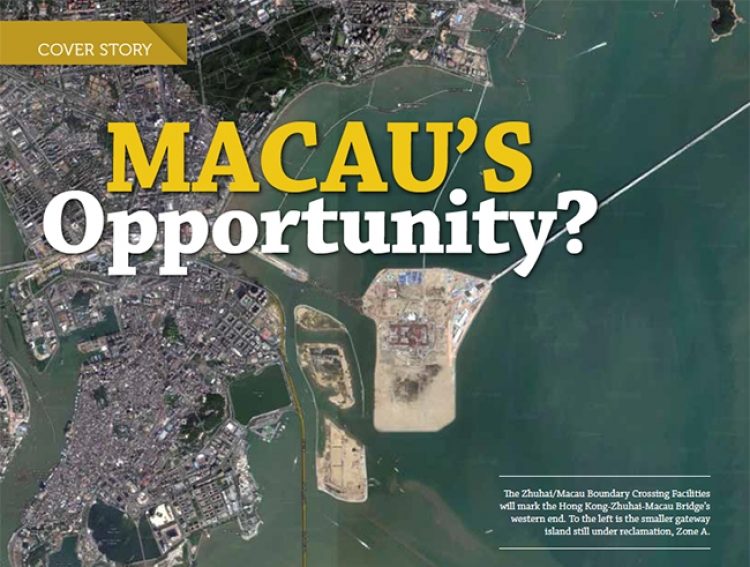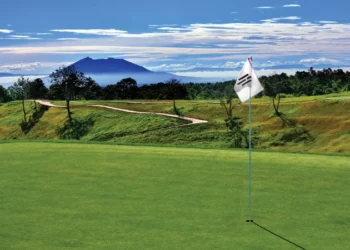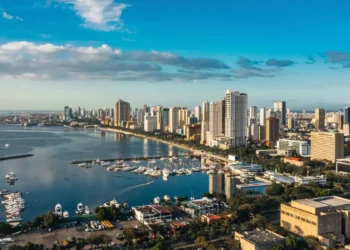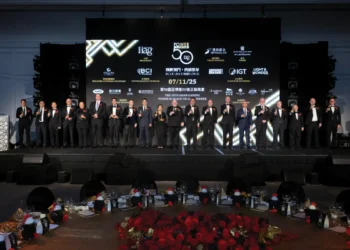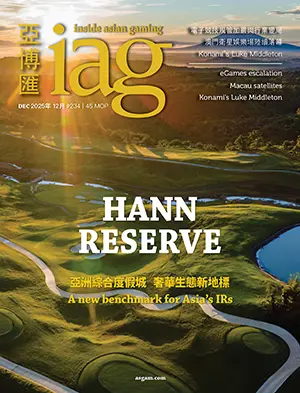How will the forthcoming mega-bridge across the Pearl Delta from Hong Kong affect Macau?
By Steven Ribet
Media in Hong Kong have been making a fuss recently over delays in the Hong Kong-Macau- Zhuhai Bridge (HMZB). The 48 kilometer, US$15 billion mega-project will allow cars and trucks to drive across the Pearl River Delta after its opening, which has been scheduled for December next year. The latest news is that China will likely finish its assigned task of building the link’s main section on time. But delays in connecting infrastructure on the Hong Kong side will likely push the project’s completion back to 2019. This lag “will result in considerable embarrassment for the Hong Kong government,” comments the news service HowardWinnReports.
The project’s route splits at its western end, with northern branches that enter Zhuhai directly without going through Macau. That’s just as well. If HMZB had to rely on Macau it might not open until well into the next decade. Macau hasn’t even started work on much of the connecting infrastructure at its end of the bridge. (Hong Kong and Zhuhai, by contrast, will be fully plugged in once HMZB opens.) And even after Macau’s transport links are finished, questions remain about the city’s ability to capitalize on the opportunity the bridge will offer. “You can’t be in a hurry if you want to lay a firm foundation,” says Dr Joey Lao of the Macau Economic Association. “The real benefits of the bridge will be reaped not in our generation but the next.”
To look at the big picture, HMZB is part of a long term vision of turning the Pearl River Delta into a “polycentric megacity region.” The big idea of Beijing’s central planners, in other words, is that development in a geographical area is more stable when it integrates several economic centers.
The fortunes of a region with only one big city will rise and fall with the cycle of that city. Witness Detroit, the collapse of which pulled down the whole of Michigan state. Growth driven by different centers, by contrast, should be more sustained. Zhuhai, for example, has lagged behind Shenzhen and Hong Kong historically, in line with the slower growth of the Pearl Delta’s quieter western bank. With the bridge, demand from the bustling eastern side should pull up Zhuhai, which will in turn lift up Zhongshan and Jiangmen to the north and west.
HMZB will not be the longest bridge in the world. That record goes to the Beijing to Shanghai high-speed railway’s Danyang- Kunshan Grand Bridge, which is 164.8 km long. And at 42.5 km, the world’s longest sea bridge spans northern China’s Jiaozhou Bay. But the Pearl Delta link will contain the world’s longest immersed tube tunnel. This will be 6.7 kilometers long, allowing the largest container ships to pass. It will be made from 200 meter prefabricated sections, lowered onto the seabed between two artificial islands at HMZB’s eastern end. From the tunnel’s western end (see map), the link will head across the water to Zhuhai, traversing 29.6 km of six-lane, low-slung causeway, punctuated by three large cable-stayed bridges to allow the passage of marine traffic. The bridge will end at a 216 hectare island of reclaimed land just east of the Macau peninsula, known as the Zhuhai/Macau Boundary Crossing Facilities.
China on its own is building this main section (sea bridge plus tunnel). Out of an estimated total cost of CNY 37.45 billion (US$5.78 billion), CNY 7 billion will be stumped up by the mainland government. Hong Kong will pay CNY 6.75 billion and CNY 1.7 billion will come from Macau. The remaining CNY 22 billion, or 59% of the cost, will take the form of a loan from the Bank of China.
Hong Kong will end up spending much more than this, however. The infrastructure connecting it to the main section (meaning work inside Hong Kong’s maritime boundary which falls at the eastern end of the undersea tunnel) will be built by Hong Kong at a cost to itself of HK$102 billion (US$13.1 billion). This eastern end will comprise a 12 km viaduct that completes HMZB (called the Hong Kong Link Road) and a 150 hectare artificial island at the end of the Link Road called the Hong Kong Boundary Crossing Facilities. Lastly will be the Tuen Mun-Chek Lap Kok Link; another undersea tunnel linking the Hong Kong Boundary Crossing Facilities with the New Territories town of Tuen Mun and, north across the border, Shenzhen at Shekou.
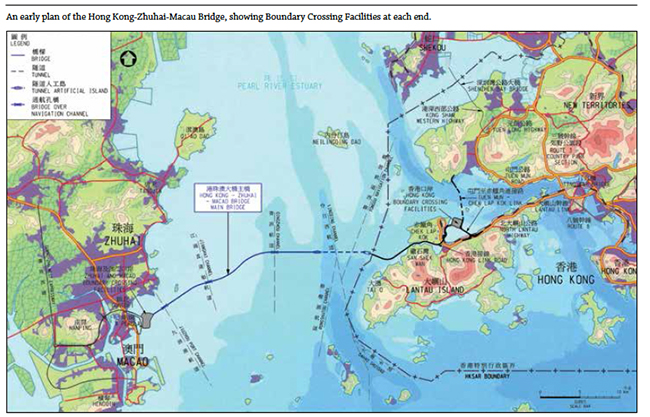
In January 2010 a Hong Kong resident challenged the validity of the Boundary Crossing Facilities’ environmental impact assessment in Hong Kong’s courts, halting construction for over a year. Hence the delay on the link’s eastern end.
Once HMZB is operational, journey by truck between Hong Kong and Zhuhai should fall from today’s 4½ hours to 40 minutes. That means Hong Kong’s logistics hub at Chek Lap Kok Airport will be the project’s chief beneficiary, handling more high-value, time-sensitive products and components from factories on the Pearl Delta’s western bank. Factories in Shenzhen and Dongguan, meanwhile, will also source more parts from across the water, where land and labor costs are lower, and make more use of Zhuhai’s cheap container port.
But Macau’s potential to gain from the increased freight will be limited. Unlike China it has no manufactured or agricultural produce to export. And unlike Hong Kong it has no shipping container port or air-freight logistics hub. The Macau/Zhuhai Boundary Crossing Facilities will in fact be a giant car park, to allow Macau-bound passengers to switch to shuttle buses and public transport once they reach the bridge’s west end. Only a very small number of vehicles coming across will be allowed to continue into the former Portuguese colony. “Macau is a tiny place suffering from traffic jams,” explains Joey Lao. “Vehicles allowed to enter would immediately add to the congestion.”
So how will Macau benefit from the HMZB link? A lot will depend on the level of the bridge’s toll fee, and Hong Kong’s willingness to relax its border controls. Hong Kong has of course been less enthusiastic about integration with the Pearl Delta region than the other way around. But if mainland visitors are granted one visa to enter both SARs, Professor Ricardo Siu of Macau University thinks the big bridge will boost multi-destination itineraries. Joey Lao, however, thinks the link will do little or nothing to boost tourism into Macau from southern China. “Visitors coming to Macau from Shenzhen will not use the bridge because they will first have to cross the border into Hong Kong, and that will take too long,” he says. “Instead they will use the Shenzhen-Zhongshan bridge further up the delta.” He is referring to a second bridge approved by Beijing, planned for construction some 32 kilometers north of HMZB. The eight-lane, 51 kilometer link should cost US$4.8 billion and is scheduled to open in 2021.
For visitors coming to Macau from Hong Kong island, HMZB will reduce crossing times from the 60 minutes it now takes to ride a jetfoil ferry, to 45 minutes on a bus. Overall journey times might be shorter still if the new trans-delta buses run more frequently than ferries, and getting a coach can also be said to be more pleasant than sitting on a boat. If Hong Kongers begin their journey in the New Territories, the time saved by using the new link should be greater. Nonetheless, the reduction in transit times between Hong Kong and Macau will not be dramatic, and given the Zhuhai/Macau Boundary Crossing Facilities is a good distance further away from visitors’ likely destinations in Macau compared to the ferry terminals, there might be little or even no reduction in transit time at all. This may limit the new link’s ability to bring in more visitors from Hong Kong.
HMZB’s biggest effect on Macau, in fact, should come from improved access to Hong Kong International Airport. “The new route from Macau to Hong Kong International Airport will be shorter than the existing route to the airport from Central Hong Kong. This worldclass aviation hub will belong to Macau,” enthuses Joey Lao, who envisages a 20 minute coach journey after remote check-in at the Zhuhai/Macau Boundary Crossing Facilities. Today, air passengers flying into Hong Kong can take a ferry from the airport directly to Macau without passing Hong Kong’s border controls – but there are only five sailings each day. The new road link should dramatically increase the frequency of departures, by coach.
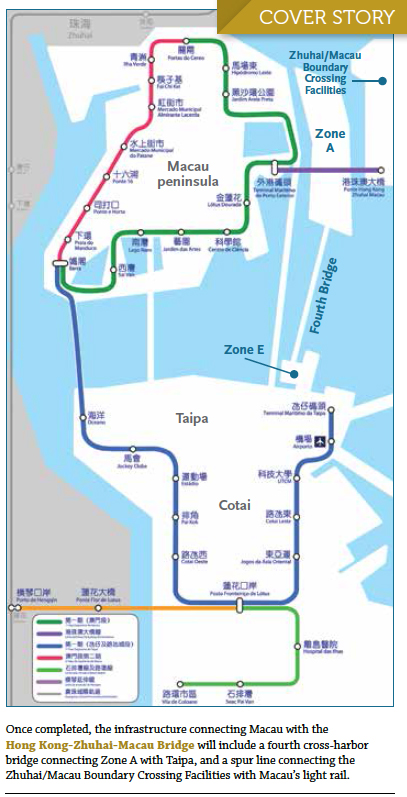
The big project could thus have a dramatic impact on Macau International Airport, which is small, offers a limited number of destinations and has been criticized as inefficient. Macau’s integrated casino resorts, for instance, may in future decide to fly in all of their Thai durian and Alaskan salmon via Chek Lap Kok’s highly efficient logistics terminal. And the number of air passengers passing through Macau airport could slump, as incoming gamblers opt instead to fly in to its swankier counterpart.
In short then, while HMZB will make little difference to tourist arrivals from Hong Kong or Southern China, it could greatly improve access to Macau from further afield. Will Macau rise to the opportunity?
Google Earth users looking down at the Zhuhai/Macau Boundary Crossing Facilities today can see two roads already linking the artificial island to mainland China. One runs north to the headland of Siu Pai, and a thicker highway route westward connects to Zhuhai’s border crossing with Macau. But work has yet to start on a direct connection to Macau itself.
Macau’s ultimate gateway to the bridge will be a 138 hectare artificial island reclaimed between the Zhuhai/Macau Boundary Crossing Facilities and the Macau peninsula, called Zone A. The completion date for this new piece of land was recently postponed, although eventually it will support enough residences to house 100,000 people. To add to this, Macau’s first Five Year Plan recently outlined a fourth cross-harbor bridge (see map). It will connect Zone A to Taipa at another area of reclaimed land on Taipa’s northeast coast called Zone E. The new span aims to make for a quick road journey from the Zhuhai/Macau Boundary Crossing Facilities, viaZone A to the casinos of Cotai. Work on it is scheduled to start next year, with opening slated for 2020.
But it’s not certain that this deadline will be met. Unfortunately Macau has not shown itself to be a world leader at building infrastructure, as is evidenced by the history of its light railway. Phase 1 of this project, comprising 11 stations on Taipa and Cotai, was originally scheduled to open in 2014. But in reality it will unlikely be operational before 2020. A second line running from Taipa up to the northern border with Zhuhai is also planned. And there should be a spur line shuttling back and forth between a station at Macau’s main ferry pier and the Zhuhai/Macau Boundary Crossing Facilities. But work has yet to start on the rail connection, so it’s anybody’s guess when it will be finished.
Joey Lao’s prediction that the full benefits of the HMZB link will be reaped by future generations in Macau may therefore be prescient. In a few years’ time, a trans-delta coach may be whisking air passengers from Hong Kong International Airport to Macau in 20 minutes. Upon arrival at the Zhuhai border, however, they may encounter the setup familiar to the Macau generation of today. That means an hour’s wait to cross over, followed by another hour of Macau-style public transport and congestion.
Even when the entire infrastructure connecting to HMZB gets built, it’s not clear if Macau will do much with the improved access for international tourists. Visitors from outside Greater China currently make up less than 10% of those visiting the city. Macau’s limited international appeal was underlined this year by a CLSA survey of Chinese tourists, which found that less 8% of those who had visited planned to return. This compared to 37% saying they wanted to make a second trip to Japan, and 32% for Thailand.
Looking at how Macau can improve its appeal as an international tourism destination is a whole different discussion. But it’s clear that a lot needs to be done before the city can take full advantage of the opportunities promised by the new Hong Kong-Zhuhai-Macau Bridge.






